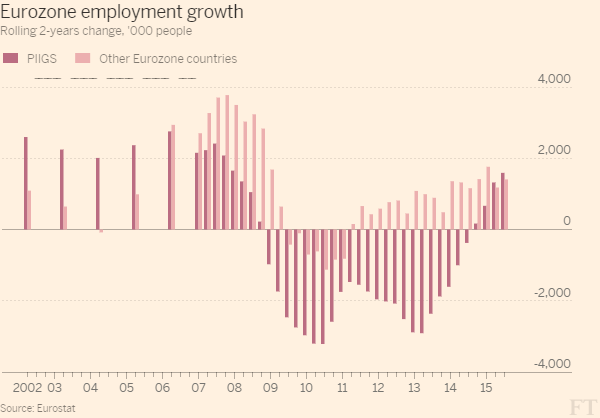Saturday 13 February 2016
Italy’s recovery: is it strong enough?
https://www.youtube.com/watch?v=CBybaoYhhBM&feature=youtu.be
The PIIGS drive employment growth in the Eurozone
The PIIGS drive employment growth in the Eurozone
There were nearly 3 million more people in employment in the third quarter of 2015 in the Eurozone than there were two years before. Of these, 1.6 million – over 53% per cent – were from the countries given the acronym ‘PIIGS’, for Portugal, Ireland, Italy, Greece and Spain.
2015 was the first year in which these peripheral countries drove employment growth in ten years. This despite total employment in the PIIGS – about 47 million – being half that of the other Eurozone economies.
Is the revenge of the countries that five years ago were grouped together in a derogatory acronym based on their common lack of growth, high unemployment and high government debt?
Yes and no.
OECD economist Paul Swain, interviewed by the FT, warned that the stronger growth is largely a rebound effect. “the PIIGS countries have been (and still are) in the process of absorbing the very high levels of labour market slack that had built up, whereas most other Euro area countries have moved beyond that phase of the business cycle”.
In the two years to the end of 2009 the PIIGS lost over 2.7 million jobs- about 5.3 per cent – compared to only 174,000 jobs in the rest of the Eurozone. In the PIIGS the decline continued for six years and reached the low point as recently as the first quarter of 2014 with a total loss of 12 per cent of the workforce.
By comparison, in the rest of the Eurozone employment shrank for less than three years and wiped out comparatively few jobs – 3 per cent from the peak in the third quarter of 2008 to the start of 2011. The recovery of the PIIGS is not yet complete and employment levels remain well below pre-crisis levels.
But the current fast employment growth is not only due to the low levels reached during the crisis. “Employment growth in the past two years almost certainly was strengthened by recent reforms in some or all of the PIIGS” adds Mark Keese Head of the Employment Analysis at the OECD, particularly in Spain where the government has enacted “measures to render wage setting more responsive to labour market conditions” and in Greece where wage levels have been reduced.
As a result, cost competitiveness increased in all PIIGS countries, except Italy.
Spain on its own added more than 800,000 jobs in the two years to Q3 2015 compared to 560,000 s in Germany, despite the Spainish labour force being half the size of Germany’s. And the data released on Thursday shows that the pace of Spanish employment recovery accelerated in the final quarter of last year.
Moreover, Spain is also creating jobs among those of core working age (25-55), while in most other Eurozone countries the recovery is concentrated among the over-55s. As a result, Spain accounts for 600,000 – around 30 per cent – of the 2 million jobs created among the 25-55 years age group in the last two years in the Eurozone. Spain is the largest contributor to this growth, despite being only the fourth largest economy.
Employment growth in peripheral countries- particularly in Spain and Ireland- has helped the recovery of household demand, with Spanish expenditure on household durable goods growing at an annual rate of 14 per cent in Q3 2015, compared to four per cent in Germany.
“It is to be hoped that rapid employment growth will continue for some time in the PIIGS countries” says Paul Swain, peripheral economies and sluggish Eurozone growth need it.
Subscribe to:
Posts (Atom)



